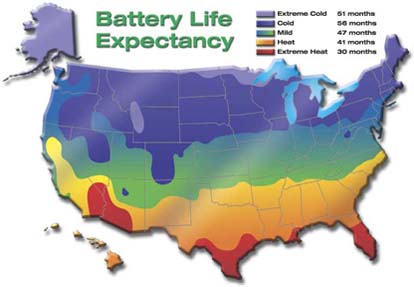
[Source: Interstate Batteries]
Last Updated on January 16, 2005
Normally, premature battery failures are caused by one or more of the failures listed below. Prior to 1980, plate or grid shorts were the most common failure. Since then the manufacturers have significantly improved the life expectancy by using improved separators, plate alloys to reduce corrosion, and heat shields. By relocating batteries to the passenger compartment (or trunk), also has considerably decreased premature battery failures. Batteries that have been in use for longer periods of time will typically fail from multiple causes. All batteries will fail at some point in time.

[Source: Interstate Batteries]
12.1. Water Loss! (Car) and Sulfation! (for batteries not used weekly)
12.2. Water Loss! (Car) and Sulfation! (for batteries not used weekly)
12.3. Water Loss! (Car) and Sulfation! (for batteries not used weekly)
12.4. For car batteries, high under hood heat or overcharging causes a loss of water (which account for over 50% of the failures); accelerated positive grid corrosion and growth; increased self discharge; or plate-to-strap shorts. For motive and stationary deep cycle batteries, high ambient temperatures above 77° F (25° C) cause accelerated positive grid growth.
12.5. Sulfation from water loss, undercharging, electrolyte stratification, excessive temperatures or prolonged periods of non-use account for approximately 85% of the deep cycle and starting battery failures that are not used weekly, vehicle charging systems based on driving habits (short trips with high loads leaving the battery constantly undercharged). (Please see Section 16 for more information on sulfation.) Data Power Monitoring Corp. reports that 90% of the deep cycle VRLA battery failures are due to the battery itself.
12.6. Deep discharges, such as leaving your lights on.
12.7. Misapplication, for example, using a starting battery in a deep cycle application, a motive deep cycle battery instead of a stationary for a UPS, an under sized battery (or battery bank) that causes discharges greater than the battery was designed for or a mismatch to the charging system.
12.8. Excessive vibration due to a loose hold down clamp.
12.9. Calcium or magnesium sulfation from using tap or reverse osmosis water.
12.10. Freezing a discharged battery.
12.11. Undercharging which reduces capacity due to incomplete conversion of sulfate back to lead which causes plate, cracked grids and cell shorts.
12.12. Old age (positive plate shedding of active material).
12.13. Fast recharging at rates greater than C/4 (amp hour capacity/four hours).
12.14. Temperatures above 80° F (26.7° C), especially above 100° F (37.8° C) during recharging. This also can cause VRLA (AGM and gel cell) battery "thermal runaway".